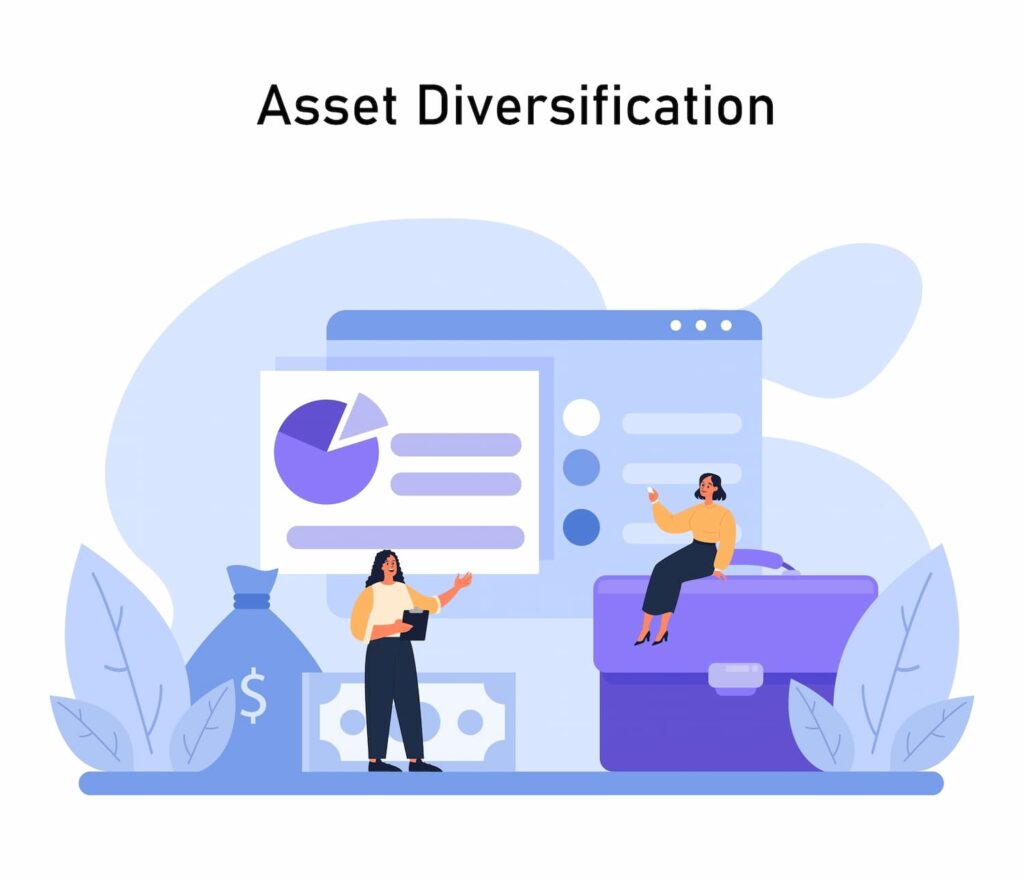
Find out 6 trading strategies every trader should know: Swing Trading, Position Trading, Day Trading, Price Action Trading, Algorithmic Trading, News Trading,etc.
Please be advised that our Client Portal is scheduled for essential maintenance this weekend from market close on Friday 5th April, 2024, and should be back up and running before markets open on Sunday 7th April, 2024.
CFDs are complex instruments and come with a high risk of losing money rapidly due to leverage. 60% of retail investor accounts lose money when trading CFDs with this provider.
You should consider whether you understand how CFDs work and whether you can afford to take the high risk of losing your money.
Let’s explore the art of portfolio rebalancing, the importance of diversification, and the ins and outs of cross-asset diversification.
In the volatile world of forex trading, one thing is sure: risk is always present. But fear not, knowledgeable traders! With the power of cross-asset diversification, you can confidently navigate these treacherous waters. In this comprehensive guide, we’ll explore the art of portfolio rebalancing, the importance of diversification, and the ins and outs of cross-asset diversification. So, buckle up and get ready to revolutionise your trading strategy!
Diversification helps mitigate risk by spreading investments across multiple assets or asset classes. Not putting all your eggs in one basket reduces the impact of any single investment’s poor performance on your overall portfolio. Diversification allows you to avoid catastrophic losses if you are heavily concentrated on one asset that experiences a downturn.
Different assets have varying levels of volatility or the degree of price fluctuation over time. By diversifying across assets with different risk-return profiles, you can smooth out your portfolio’s overall volatility. When one asset class experiences high volatility, others may remain relatively stable, helping to balance out the fluctuations in your portfolio’s value.
Diversification can lead to more consistent returns over time. While individual assets may experience periods of outperformance and underperformance, a diversified portfolio can provide more stable and predictable returns by capturing the average performance of all its assets. This can help reduce the likelihood of experiencing extreme highs and lows in investment performance.
Asset and asset classes react differently to market conditions, economic trends, and geopolitical events. By diversifying your portfolio, you gain exposure to multiple investment opportunities and sources of potential return. This allows you to capitalise on different market environments and profit from sectors or assets performing well while mitigating losses in others.
Diversification can protect your portfolio against systemic risks that affect entire markets or sectors. Economic recessions, geopolitical conflicts, or regulatory changes can impact specific industries or asset classes. By diversifying across assets from different industries, you reduce exposure to these systemic risks and increase your portfolio’s resilience.
Diversification is crucial for preserving and growing wealth over the long term. Maintaining a diversified portfolio reduces the likelihood of suffering significant losses that could derail your financial goals. Diversification helps protect your capital during downturns and allows you to benefit from the compounding effects of investment returns over time.
Diversification allows you to achieve a more favourable risk-return trade-off. Balancing risk across different assets can optimise your portfolio’s risk-adjusted returns. Diversification enables you to seek higher returns while managing risk within acceptable levels, aligning with your investment objectives and risk tolerance.

Portfolio rebalancing is realigning your investments to maintain your desired asset allocation. Over time, market fluctuations can cause your portfolio to drift away from its original balance. Rebalancing ensures you stay on track with your investment goals and risk tolerance. It involves selling assets that have performed well and buying more of those that have underperformed, bringing your portfolio back into equilibrium.
Certainly! Cross-asset diversification, also known as asset class diversification or multi-asset investing, is a strategy that involves spreading investments across different types of assets or asset classes to achieve a well-balanced and diversified portfolio. Here’s a more detailed explanation of what cross-asset diversification entails:
Cross-asset diversification involves investing in a mix of asset classes that have low correlations with each other. These asset classes typically include:
– Equities (stocks)
– Fixed-income securities (bonds)
– Cash and cash equivalents
– Real estate
– Commodities
– Alternative investments (hedge funds, private equity, etc.)
– Foreign currencies (forex)
The primary objective of cross-asset diversification is to reduce overall portfolio risk by spreading investments across assets with different risk-return profiles. Since different asset classes tend to perform differently under various market conditions, diversifying across them helps mitigate the impact of adverse market movements on the portfolio’s value.
The key to effective cross-asset diversification is investing in assets with low correlations or negative correlations. Correlation measures the degree to which the prices of two assets move in relation to each other. Assets with low correlations tend to move independently of each other, providing diversification benefits. For example, when stocks decline, bonds or gold may appreciate, offsetting losses in the stock portion of the portfolio.
Cross-asset diversification enables investors to achieve a more favourable risk-return trade-off. Investors can optimise their portfolio’s risk-adjusted returns by combining assets with different risk levels, return potentials, and correlations. This means seeking higher returns while managing risk within acceptable levels, aligning with investment objectives and risk tolerance.
Diversifying across multiple asset classes allows investors to capitalise on market opportunities and economic trends. For example, during periods of economic expansion, equities may outperform bonds, while during market downturns, bonds or defensive assets like gold may provide stability and preserve capital. Diversifying across asset classes allows investors to adapt their portfolios to changing market conditions and profit from various investment opportunities.
Cross-asset diversification enhances portfolio stability and resilience by reducing the concentration risk inherent in single-asset strategies. By spreading investments across a broad range of assets, investors can better withstand market volatility, economic shocks, and geopolitical uncertainties. Diversification helps protect capital during downturns and provides a smoother investment experience over the long term.
Certainly! Diversification across various asset classes is fundamental to building a robust investment portfolio that can weather market volatility and achieve long-term financial goals. Let’s explore the key asset classes for diversification in more detail.
Equities represent ownership stakes in publicly traded companies. Stocks offer the potential for high returns over the long term but come with higher volatility and risk. Investing in a diversified portfolio of stocks allows you to participate in the growth of various industries and sectors, spreading risk across different companies.
Bonds are debt instruments issued by governments, municipalities, or corporations to raise capital. They provide investors with regular interest payments (coupon payments) and a return of principal at maturity. Bonds offer lower volatility and serve as a source of income and capital preservation in a diversified portfolio. They also act as a hedge against equity market downturns.
Cash and cash equivalents include highly liquid assets such as savings accounts, money market funds, and short-term Treasury bills. While cash investments typically offer lower returns than stocks and bonds, they provide stability and liquidity, serving as a haven during market uncertainty. Cash equivalents are crucial for maintaining liquidity and meeting short-term financial needs.
Real estate investments encompass residential, commercial, and industrial properties and real estate investment trusts (REITs). They offer diversification benefits by providing returns less correlated with traditional financial assets like stocks and bonds. Real estate investments generate rental income and potential capital appreciation, making them an attractive alternative asset class for diversification.
Commodities are physical goods such as gold, silver, oil, agricultural products, and industrial metals. Investing in commodities provides diversification benefits due to their low correlation with traditional financial assets. Commodities hedge against inflation, currency fluctuations, and geopolitical risks. They can also enhance portfolio returns during economic uncertainty or commodity price spikes.
Alternative investments include hedge funds, private equity, venture capital, private real estate, and infrastructure projects. Alternative investments offer diversification benefits by providing exposure to non-traditional asset classes and investment strategies. These investments often have low correlations with stocks and bonds, reducing portfolio volatility and enhancing risk-adjusted returns.
Forex trading involves buying and selling currencies in the foreign exchange market. Investing in foreign currencies provides diversification benefits by exposing investors to global economic trends and geopolitical events. Forex investments can hedge against currency risk and provide opportunities for profit in currency fluctuations. However, forex trading carries inherent risks, including exchange rate volatility and geopolitical uncertainty.
Certainly! Implementing effective strategies for cross-asset diversification is essential for building a well-balanced investment portfolio that can withstand market volatility and achieve long-term financial goals. Here’s a deeper exploration of methods for cross-asset diversification.
Asset allocation is the foundation of cross-asset diversification. It involves determining your portfolio’s optimal mix of asset classes based on your investment goals, risk tolerance, time horizon, and market conditions. Common asset allocation strategies include:
Risk-based allocation involves allocating capital across asset classes based on their risk profiles. This strategy aims to balance risk exposures within the portfolio while seeking to achieve desired levels of return. Assets with higher risk may include equities and commodities, while assets with lower risk may include bonds and cash equivalents. By diversifying across assets with different risk levels, investors can manage overall portfolio risk more effectively.
Factor-based investing involves targeting specific factors or characteristics that drive asset returns, such as value, size, momentum, and quality. By investing in assets with exposure to different factors, investors can diversify their sources of risk and return. Factor-based strategies may include:
Strategic overweighting and underweighting involve adjusting portfolio allocations to overweight assets that offer attractive opportunities for returns and underweight assets that may be overvalued or present higher risks. This strategy allows investors to capitalise on market inefficiencies and exploit mispricing across asset classes. Overweighting may involve allocating more capital to undervalued sectors or asset classes, while underweighting may include reducing exposure to overvalued or risky assets.
Global diversification involves investing in assets from different geographical regions and economies to reduce country-specific risks and benefit from global growth opportunities. By diversifying internationally, investors can gain exposure to diverse market dynamics, economic cycles, and geopolitical developments. International diversification can enhance portfolio resilience and reduce reliance on any country or region for returns.
Including alternative investments such as hedge funds, private equity, real estate, and infrastructure in your portfolio can provide additional diversification benefits. Alternative investments often have low correlations with traditional asset classes like stocks and bonds, helping to reduce overall portfolio volatility and enhance risk-adjusted returns. However, alternative investments may also introduce liquidity, complexity, and regulatory risks that require careful consideration.
Dynamic rebalancing involves reviewing and adjusting portfolio allocations to maintain desired risk and return objectives. This strategy requires active monitoring of market conditions, economic trends, and asset valuations. By dynamically rebalancing the portfolio in response to changing market dynamics, investors can adapt to new opportunities and risks while staying aligned with their investment goals.
Certainly! Rebalancing a diversified portfolio is a critical aspect of portfolio management that involves periodically adjusting the allocation of assets to maintain your desired level of diversification and risk exposure. Here’s a more detailed explanation of the process.
Portfolio rebalancing is the process of realigning the asset allocation of your investment portfolio to bring it back in line with your target allocation. Over time, as different asset classes or individual investments perform differently, your portfolio’s asset allocation can drift away from your original investment plan. Rebalancing ensures that your portfolio remains consistent with your risk tolerance and investment objectives.
Rebalancing is essential for several reasons:
The frequency of portfolio rebalancing depends on your investment strategy, risk tolerance, and market conditions. While there is no one-size-fits-all approach, investors commonly rebalance their portfolios annually, quarterly, or whenever asset allocations deviate significantly from their target levels. Balancing portfolio discipline and minimising transaction costs and tax implications is essential.
When rebalancing your portfolio, follow these steps:
Some investors automate the rebalancing process using portfolio management tools or robo-advisors. These platforms automatically rebalance your portfolio at predefined intervals or when deviations from target allocations exceed a certain threshold. Automation can streamline the rebalancing process and ensure disciplined portfolio management.
After rebalancing your portfolio:
Let’s delve deeper into the crucial risk management considerations regarding trading and investing across various asset classes.
Understand Your Risk Tolerance:
Before embarking on any investment journey, it’s essential to understand your risk tolerance. This refers to your ability and willingness to endure fluctuations in the value of your investments. Assessing your risk tolerance involves considering your financial situation, investment goals, time horizon, and emotional temperament.
Diversification as a Risk Mitigation Strategy:
Diversification is a cornerstone of risk management. By spreading your investments across different asset classes, industries, and geographical regions, you can reduce the impact of any single investment’s poor performance on your overall portfolio. Diversification helps to smooth out volatility and minimise the risk of significant losses.
Asset Correlation and Diversification:
Consider the correlation between different asset classes when diversifying your portfolio. Assets with low or negative correlations tend to move independently of each other, providing better diversification benefits. For example, during stock market downturns, safe-haven assets like gold and government bonds may perform well, offsetting losses in equities.
Position Sizing and Risk Allocation:
Proper position sizing is crucial for managing risk. Avoid overexposing your portfolio to any single asset or market. Allocate capital based on each asset’s risk-return profile, considering factors such as volatility, liquidity, and correlation with other portfolio holdings. Implement risk management techniques like the 2% rule, which limits each trade’s risk to no more than 2% of your total trading capital.
Risk vs. Reward:
Every investment involves a trade-off between risk and reward. Higher potential returns typically come with higher levels of risk. It’s essential to balance risk and reward in a way that aligns with your investment objectives and risk tolerance. Avoid chasing excessively high returns without considering the associated risks.
Use of Stop-Loss Orders:
Implementing stop-loss orders is a proactive risk management strategy. A stop-loss order specifies a price at which a trade will be automatically exited to limit losses. Setting stop-loss orders can protect your capital and prevent emotional decision-making during market volatility.
Continuous Monitoring and Adjustments:
Markets are dynamic, and risk factors evolve. Regularly monitor your portfolio’s performance and market conditions. Stay informed about economic indicators, geopolitical events, and other factors that could impact your investments. Adjust your portfolio and risk management strategies to adapt to changing market conditions.
Stay Informed and Educated:
Knowledge is power when it comes to risk management. Stay informed about investment principles, market trends, and risk management techniques. Continuously educate yourself through reputable sources, financial news, and industry publications to effectively make informed decisions and navigate market uncertainties.
Before diving into asset allocation, it’s crucial to define your investment goals and assess your risk tolerance. Are you investing for long-term growth, income, or capital preservation? Understanding your objectives will guide your portfolio construction.
Familiarise yourself with the unique characteristics of each asset class:
Determine the ideal mix of asset classes for your portfolio based on your investment goals and risk tolerance. This allocation will depend on your investment horizon, financial situation, and risk appetite.
Within each asset class, choose investments that provide broad diversification and complement each other’s risk-return profiles. For example:
Markets are dynamic, and asset classes can perform differently over time. Regularly review your portfolio to ensure it stays aligned with your target asset allocation. If certain assets have become over or underweighted due to market movements, rebalance your portfolio by buying or selling assets to bring it back into equilibrium.
While diversification can mitigate risk, it’s essential to implement risk management strategies to protect your portfolio further. This may include setting stop-loss orders, diversifying within asset classes, and incorporating hedging techniques.
Stay informed about global economic and geopolitical developments that could impact your portfolio. Monitor currency trends, commodity prices, stock market indices, and geopolitical events to make informed investment decisions.
In conclusion, mastering risk management through cross-asset diversification is essential for success in trading. By spreading your investments across different asset classes, you can confidently reduce risk, enhance returns, and achieve your investment goals. So don’t wait any longer – start diversifying your portfolio today and take your trading strategy to the next level!

Find out 6 trading strategies every trader should know: Swing Trading, Position Trading, Day Trading, Price Action Trading, Algorithmic Trading, News Trading,etc.

This article provides an overview of exit strategies in trading and why they are essential for long-term success.

This article explores gold trading strategies, providing insights into why you should trade gold, and an analysis of the advantages and disadvantages of each strategy.

Our customer services team is here to answer any of your questions. From technical how to questions, to general trading, we re here to help

When you sign up with us, we ll assign you a dedicated relationship manager to help you on your trading journey
Risk Warning
CFDs are complex instruments and come with a high risk of losing money rapidly due to leverage. 60% of retail investor accounts lose money when trading CFDs with this provider. You should consider whether you understand how CFDs work and whether you can afford to take the high risk of losing your money.
Please click here to view our Risk Disclosure.
Hantec Markets use cookies to enhance your experience on our website. By staying on our website you agree to our use of cookies. You can access our Cookie Policy here
Risk Warning
CFDs are complex instruments and come with a high risk of losing money rapidly due to leverage.
You should consider whether you understand how CFDs work and whether you can afford to take the high risk of losing your money.
Please click here to view our Risk Disclosure.
Hantec Markets use cookies to enhance your experience on our website. By staying on our website you agree to our use of cookies. You can access our Cookie Policy here
Hantec Markets is a trading name of Hantec Group.
This website is owned and operated by Hantec Markets Holdings Limited. Hantec Markets Holdings Limited is the holding company of Hantec Markets Limited and Hantec Markets Ltd.
Hantec Markets Limited is authorised and regulated by the Financial Conduct Authority (FCA) in the UK (Register no: FRN 502635).
Hantec Markets Ltd. is authorised and regulated as an Investment Dealer by The Financial Services Commission of Mauritius (License no: C114013940).
The services of Hantec Markets and information on this website are not aimed at residents of certain jurisdictions, and are not intended for distribution to, or use by, any person or entity in any jurisdiction or country where such distribution or use may be contrary to any of the laws or regulations of that jurisdiction. The products and services described herein may not be available in all countries and jurisdictions. Those who access this site do so on their own initiative, and are therefore responsible for compliance with applicable local laws and regulations. The release does not constitute any invitation or recruitment of business.
Hantec Markets does not offer its services to residents of certain jurisdictions including USA, Iran, Myanmar and North Korea.


We are transferring you to our affiliated company Hantec Trader.
Please note: Hantec Trader does not accept customers from the USA or other restricted countries.